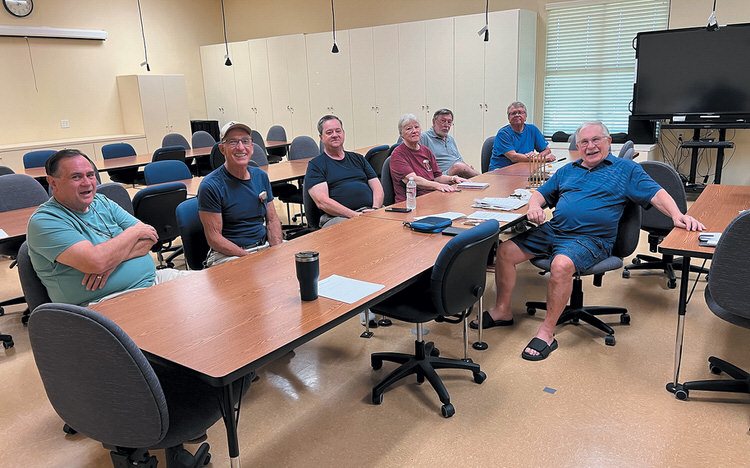
Pen making class
Lorraine Wilson
On July 19 the Robson Ranch Woodworkers Pen Club held a training class for aspiring pen makers. The first pen making class was held on July 15, 2020, and, to date, 52 members have completed the pen class. There are several prerequisites to taking the pen class, such as completing the safety training class and having a basic knowledge of the band saw, mini lathe, power sander, and carbide lathe turning tools. Classes are held about four times a year and usually have four to six students. The class starts in a classroom, which covers all the steps in making pens, then the class is adjourned to the woodshop where hands-on lathe training is provided. Each new student is assigned a mentor to help guide them through their first two pens, a Slimline and a Saturn.
Once a student has completed the training, they are invited to join the Pen Club. The Pen Club meets monthly on the first Wednesday of the month. Monthly club meetings are filled with fascinating information about the many types of wood, what their hardness rating is on the Janka scale, where in the world they come from, along with introduction of many types of pen styles and methods for making them. Pen Master Loren Christensen, the club leader and expert, has turned thousands of beautiful pens and is an inspiration to everyone who has learned to turn a pen. There are several other very skillful master pen makers in the club who mentor new members on the art of turning a pen.
The process to become a pen master is a rigorous one. Pen aficionados go through a step-by-step training program and must make 10 different types of pens along the way. All pen makers begin with the Slimline pen and a Saturn pen and, as they gain experience, will complete Longwood; Euro with Tenon; Euro without Tenon; Premium Designer; Slimline Pro; a Single-Barrel Click Pen such as a Vertex, Compson, or Mesa; a Cigar pen; and, finally, a Zen Rollerball Pen. Successfully completing these pens earns a master pen maker designation, and they can then mentor others in the fabulous craft of making pens.
Pens have been around since 3200 BC when pens were carved from plants such as bamboo and reed as the base of the pen. These early pens were used to carve hieroglyphs on clay tablets. In 600 AD quills were used as pens. At that time, inexpensive quills were made from goose feather, while expensive ones were made from swan feathers. The end of the feather was sharpened with a knife and dipped into ink to write on parchment. Steel-point pens were invented around 1822, but they still had to be dipped in ink but were less expensive than quill pens. Only a few years later, around 1827, the fountain pen was invented. This type of pen holds ink inside, which passes through a nib when it touches paper. In 1884 Lewis Waterman developed a three-channel ink feed fountain pen, which ensured a smooth flow of ink when writing. The invention of the ballpoint pen followed shortly thereafter in 1888. The purpose of the small rotating ball was to prevent the ink from drying out and to distribute the ink smoothly.
Even in this day of computers and technology, pens are still important tools in our everyday lives. The ability to turn and make a unique pen and give it as a gift is a skill many have become enthralled with. If you are interested in learning how to make a pen, stop by the woodshop and sign up for the next pen class. We guarantee you’ll enjoy this experience of woodworking. The woodshop also has many handmade pens in our display window, and they are all for sale.
